Don't wanna be here? Send us removal request.
Text
How To Introduce A Pet To Your Baby

How do you introduce your baby to your pet? If a new pet is joining your family soon, you especially need to prepare for the transition. Babies and pets can be a tricky combination and you need to take a proactive approach before you bring a pet home.
Remember that when a baby meets the pet, it might not be love at first sight.
Introduce Them with Care
The first encounter between your pet and baby can set the tone for the relationship. When introducing the baby to the pet, it is advisable to get down on their level and let them sniff. Pets sniff to recognize new smells. Don’t pull your baby away unless the pet is exhibiting aggressive behavior.

Desensitize the Pet to New Sound, Smell and Sight
Babies sound and smell differently from adults. Pets are usually used to adult smells and sounds. It is advisable to desensitize the pet to the sound and smell of the baby, so that they are not stressed when you introduce the pet to the baby.
Learn Safety Basics
Before you introduce the baby to the new pet, it is important that you learn safety basics. Never leave the baby alone with a pet, as even the gentlest of animals can react in an unpredictable manner. Set limits to how much the pet can access your baby. Keep the toys separate.
Take Your Pet to a Vet
Schedule a visit to the vet for a full examination to ensure that the pet is not experiencing any undiagnosed health problems.
Babies are sensitive and if you have a pet with a health issue, it can be challenging and stressful. Get the pet treated if it has any kind of health issues before introducing it to the baby. It is advisable to allow only healthy pets to play with your baby.

Help Baby and Pet Bond and Settle Down
Let them play together. Give your pet equal attention when playing. When they feel that they are included, they are less likely to act up. The baby will initially be oblivious to the presence of the pet but with time, he or she will start discovering a friendly and loving creature. A pet can provide new sensations, and this can help in the development of the baby.
When the baby starts crawling and walking, you need to be extra careful. Pets are often playful and when they see the baby crawling or walking for the first time they might get excited and jump on them. Keep a close watch so that you can safeguard both from danger.
A pet or new baby brings many changes to the household and it is best if you are prepared. Never rush things, as it will take time for the baby and pet to establish a bond. Be patient and take one step at a time. Ensure that they interact on a regular basis and are comfortable with each other’s presence. With time, the baby and pet will develop a bond and friendship that will last a lifetime.
0 notes
Text
Should You Get A Pet Bird? 8 Things To Consider

“Polly want a cracker?”
Many people think that owning a playful, colorful parakeet or parrot will be nothing but fun, but living with one is far different from the assumption that all you’ve got to do is refill their birdseed and water every day.
Even birds as small as parakeets can live 5 to 8 years, and African grey parrots and Macaws can live from 35 to 50 years or more. That’s a huge commitment.
Here are eight essential things to consider before you bring home a pet bird.
1. Sensitivity
Birds cannot tolerate houseplants, smoke, hairspray, perfume, air fresheners, scented candles or Teflon-coated cooking pans. In fact, the invisible fumes that come from cooking on Teflon-coated pans are fatal to birds. Their respiratory systems are extremely sensitive and cannot tolerate any of these substances.
2. Disease
Birds can transmit airborne diseases (including avian tuberculosis) to humans, and their dander can aggravate those who suffer from breathing problems such as asthma, COPD, and emphysema. HEPA air filters can help reduce feather dander, but if anyone in your home is sensitive, maybe another type of pet would be a wiser choice.
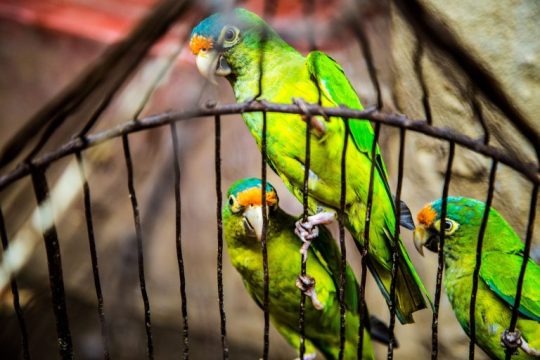
3. Noise
Unless you’re happy with small, jumpy finches or canaries who make little peeps throughout the day (both of which are not generally sweet and loving), be prepared for a lot of noise. Even parakeets – as small as they are – can cause you ear pain, if not hearing loss if they decide to chirp on your shoulder for an extended amount of time. The only time it’s quiet is at night. Another thing to keep in mind: As with chickens, domesticated birds wake up with the sun. If you can’t handle that, consider placing their cages in a windowless room.
4. Mess
Birds eat constantly when it’s light outside. There is no such thing as three meals a day. Whatever seeds they eat come in two parts: the hull and the meat. They remove the hulls and eat the meat, and the hulls drop to the floor. You’ll have to vacuum at least once a day. Keep in mind, too, that pet birds will shred paper, wood, plastic, cords and anything they can get their beaks around.
5. Flight
Unless you want your bird to fly around the house or even escape through the front door and possibly get lost forever, you must clip their wings. Don’t attempt to do this on your own without learning how to clip wings correctly. Done properly, the task is as easy as clipping your nails. Done incorrectly and you could permanently damage the bird’s ability to fly. If you’re nervous, you can take the bird to the vet or to the place you adopted him from to have professionals do the job.

6. Room
When you buy your bird, make sure that it lives in a cage large enough that it can move around and flap its wings, or install some prefab branches (available at your local pet store) somewhere in your home so it can land there to rest. If you don’t want to house your bird inside your home, you can build a separate aviary for its comfort.
7. Attention
Birds are like human toddlers. They’re social creatures who adore constant attention from their humans. And that includes scratching under their wings, rubbing their necks and letting them sleep in your shirt pocket (if they’re small enough). If you’re not the cuddly type, then perhaps seek out a pet that prefers solitude.
8. Biting
A parakeet can bite hard enough to draw blood. A Macaw can take your finger off. Never taunt a bird with anything you can’t afford to lose, and be very careful when they get near your face. Birds usually won’t bite down with all their strength unless they feel threatened, but it’s better to be safe than sorry, even if your pet has been in your home for years.
Birds are extremely loving, loyal pets, but owning them is a major commitment of time and effort. If you determine that they’re right for you and your family, you’ll be rewarded with a lifetime of love.
0 notes
Text
5 Cat Breeds That Make Excellent Pets

Do you identify yourself as a dog person rather than a cat person? Do you think dogs are affectionate while cats are aloof and demanding? Many people have misconceptions about cats because of prior experience or the way they are portrayed in movies or television. The truth is, there are plenty of cat breeds that are affectionate, playful, and loyal companions.
Here are the top five breeds if you want to add one to your family.
Birman

Looking for a cat with an illustrious bloodline? The Birman breed were protectors of the Burmese temples and they’ll be happy to protect you in your home as well. These beautiful cats are sturdy and have long, silky coats that are resistant to matting. With blue eyes and dark points on the ears, face, legs and tail, this striking breed will bring plenty of oohs and ahhs from adoring visitors.
American Short-hair

The American short-hair comes in so many different types of colors and patterns that you may not even realize this is the breed you’ve selected at the pet store or shelter! An athletic cat with a lifespan of up to 20 years, the American shorthair can get along with kids, dogs, and other cats well. If you want a healthy cat that doesn’t need a lot of grooming, this could be the one for you.
Ragdoll

Want a cat who remains kitten-like into old age? Then a Ragdoll might be perfect for you! Named after the limp and floppy way it reacts to being held, the Ragdoll is one of the most gentle and affectionate cats out there and is ideal for young children. Though it requires regular grooming, this big lap cat is well worth the work. This is not a breed to let outside or near other aggressive animals, though, as it’s notoriously bad at defending itself.
Maine Coon

The Maine Coon is one of the most beautiful breeds with its long striped fur, large, wide paws, white vest, and fluffy tail that is handy for wrapping itself up in during the cold. An agreeable larger cat that loves snuggling as well as playing, the Maine Coon is a great mouser and is generally incredibly healthy and up for facing any type of weather. It will love following you from room to room and giving you a playful head butt whenever it wants some extra attention.
Abyssinian
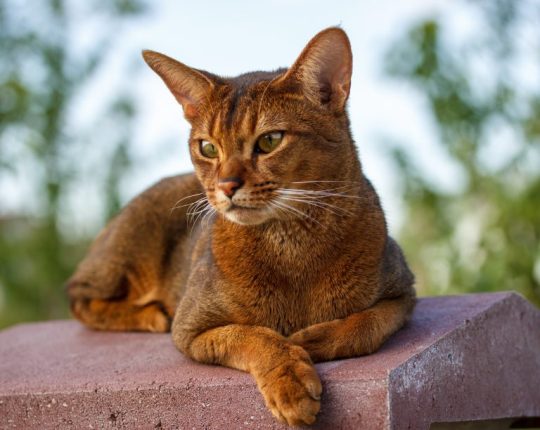
Want a truly striking-looking cat? Choose an Abyssinian, one of the oldest breeds of cat that looks like it’s straight out of an Egyptian temple. Smart and extroverted, this breed loves playing games and is one of the only breeds that will actually seek out water and baths. A bold breed, the Abyssinian willingly interacts with all family members and even strangers though it tends to be a homebody and doesn’t enjoy travel.
A cat can make a wonderful addition to your family and provide love and companionship for many years. Make sure you take a look at your family dynamic and what your needs are in a pet before choosing a breed that will be just right for you.
0 notes
Text
What You Need To Consider Before Getting A Cat
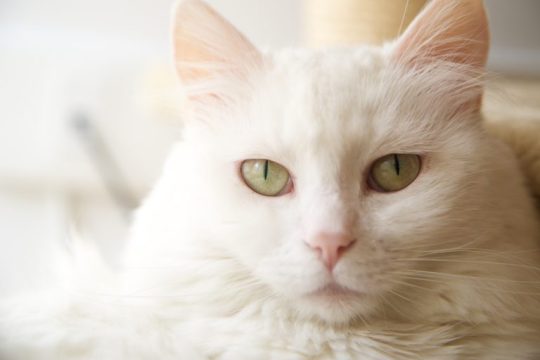
Finding out what pet is best for you and your family isn’t a journey that should be taken lightly. Dogs, cats, turtles, birds and reptiles are amongst the most popular pets. Of these, cats are the most apartment-friendly and widely-admitted pets into controlled living situations. Add to that the well-known fact that cats are independent and don’t need a ton of care, as dogs or birds do, and cats may seem like the perfect fuzzy addition to your family. But no pet is perfect. Here are seven things you must consider before bringing home a cat.
1. Allergies
Do you know if you’re allergic to cats? It’s not a condition you’re necessarily born with, and it can surface at any time and even between different cat breeds. Before you bring a cat home, have yourself tested for feline allergies. It will save the hassle and potential heartbreak later on if you find you’re allergic after the fact and have to return your cat.
2. Commitment
Cats generally live from 13 to 18 years of age, with many living into their 20s. Having a cat is a huge time commitment, so make sure you’re aware of it before adopting. On that same note, overpopulation is a huge problem in the United States, so do your part to control it by having your cat spayed or neutered.
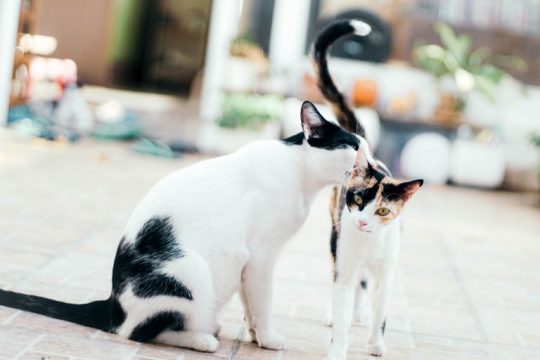
3. Grooming
Cats scratch. It’s not an obsessive-compulsive disorder, but rather a habit that keeps their paws healthy. As cats scratch the carpet, your furniture and other surfaces, it helps them shed the outer nail layer and bring up a fresh claw. To help this process, do two things: trim your cat’s nails at least once every three weeks, so they don’t destroy everything around them, and give them a sturdy scratching post that they can destroy to their heart’s content.
4. Must-Haves
Every cat should have a designated bed to sleep in, even if he/she chooses your lap or the couch. Make sure your cat has proper ID on his collar and a current microchip in case he escapes from your house. Food and water dishes, along with grooming tools and a litter box round out the must-haves for your cat.
5. Kitty Litter
If your cat is an indoor cat, it needs a litter box on each floor of your home. And keep this in mind: Most cats will not use a full or unclean litter box, so you have to be diligent about scooping out the mess and keeping the box pristine. Guests to your home will also thank you.

6. Toxic Substances
Many houseplants can be toxic to your cat, so replace them with silk versions. Also, while you might think that cats can eat anything, that’s not true. Avocados, grapes, raisins and raw meat are harmful, so keep them out of reach at all times.
7. Vaccinations
Cats are vulnerable to feline AIDS, leukemia, rabies and other deadly illnesses. Consult your veterinarian to make sure your cat is properly immunized.
Pet ownership is a commitment, but there’s nothing like the unconditional love you get in return. You and your family will benefit for years to come; and if you adopt from a shelter instead of a pet store or breeder, you’ll be saving a life, too.
If you decide that getting a cat is right for you, check out 5 Cats Breeds That Make Excellent Pets.
0 notes
Text
6 Tips For Taking Your Pet On A Road Trip

It’s so hard to leave Fido or Fluffy behind when you go away on a road trip, you might decide it’s best to take them with you. Whether your faithful friend is a dog, cat or other pet, here are six things to consider when taking your pet on a road trip.
1. Why are you taking your pet on this trip?
If there is no one else to take care of your pet while you’re gone, then you don’t have much of a choice. But if there is someone, leaving your pet in their familiar surroundings is probably for the best for everyone. Some pets do well in kennels and some don’t, so a lengthy stay may not be a good choice for all. But, you can still consider daycare for your pet as needed while on your trip.
If money for a kennel is a factor into whether you take your pet, remember there will likely be extra expenses at the hotels on the road with a pet, too.
If you are traveling to the home of a friend or family member where your pet is welcome, it’s certainly a good alternative to leaving them home with a caretaker.
2. How will they travel?
Car trips aren’t too much of a problem, except for the choice to keep them in a crate or pet pouch, or let them roam free to be with other family members. Leaving them untethered can be considered a hazard for an active pet.
Don’t forget that your dog or cat will need time at each gas or rest station to stretch their legs and do their business in the same way that your family will.
Be sure to bring pet food, bottled water, dishes for both – and a towel is always good to have around for spills.

3. What will you do with the pet when you stop and want to eat, shop, or sightsee?
While some climates are temperate, there are many times of the year when it is dangerous to leave your pet in your car due to extreme cold or heat. In some areas there are laws against this and animal activists who will break your car window to rescue a “trapped” pet. Never leave a pet unattended or in a car with closed windows.
4. Where will you stay with your pet if you have a multi-day drive and need to book a room?
First check out the many sources on the internet. Google “pet-friendly hotels.” Some of the sites will even show you the route you’re taking and the pet-friendly hotels along the way. Be sure to check to see if your pet in particular is one they’ll accept. While dogs and cats are commonly welcome, snakes, birds, hedgehogs, and pot belly pigs may not be. Breaking their rules can get you put out or fined.
If you are sure of where you want to stop, book your room(s) in advance, or be sure to book them in the early afternoon each day you travel so they don’t fill up and you have to drive a lot longer to get to the next available accommodations.
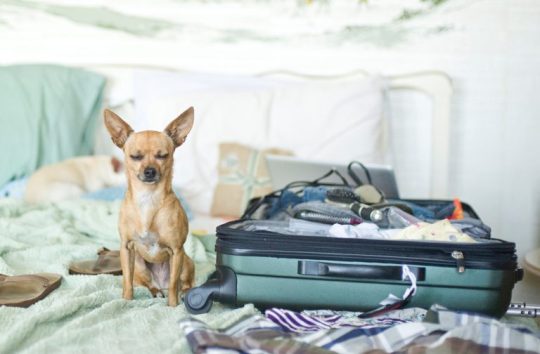
5. Can I leave my pet in my hotel room and go out?
Many hotels don’t want you to leave your pet as they need their staff to come in to clean the room. They don’t want the responsibility of chasing your pet down the hall because it bolted out as soon as the door was opened.
If it is allowed it will really depend on whether your pet makes a lot of noise. A constantly barking dog or a yowling cat will certainly irritate your neighbors and get complaints to management.
An angry pet in unfamiliar surroundings may also do damage they wouldn’t do at home. You really don’t want to be paying for what they destroy while you were gone.
If you’re in a large urban area and need to leave your pet for some time, look into local animal care businesses. Where there are people, there are pets and where there are pets, there are vets.
Whether it’s a kennel or a vet that takes in daycare animals, that will be much better than coming back from your fun and getting kicked out of your hotel.
6. What about licensing?
Be sure to have all your shots and pet licenses updated and bring the paperwork from your vet to prove they’re covered in case you are stopped and questioned. It’s especially good to have the paperwork proof of any rabies shots required if you are traveling to another country.
So, give all of this some thought and make the right choices for your pet and your trip. Enjoy!
0 notes
Text
10 Smartest Animals On The Planet

Although the human intellect is remarkable, we are not the only species on the planet to develop intelligence. Cognitive thinking, learning behavior, adaptability, and communication through body language and even vocalization are shared by other members of the animal kingdom. Here are the 10 smartest animals on the planet – other than humans.
Dogs
Dogs are as smart as a two-year-old human toddler, according to Live Science. They are extremely social beings and know when they’ve misbehaved. They can learn to understand 165 human words on average, with a few reaching the 250-word level. Some dogs have the ability to sense illness in humans, such as cancer, impending strokes or epileptic seizures, and other forms of distress.

Chimpanzees
One of our closest living relatives, chimpanzees (who in a group are called a troop) share much of the same DNA as humans. They are adept with tools (such as using stones to crack open nuts) and have been successfully taught to communicate with humans via sign language. A chimp named Washoe learned 350 words of American sign language and even taught some of these signs to her son.
Crows
These sinister looking creatures are actually very friendly and intelligent. They have photographic memories and love to steal and hoard objects. A group of crows is called a “murder” and are able to communicate with each other when danger is near.

Elephants
These gentle giants have been known to use sticks or palm fronds to swat at flies and mosquitos. They are incredibly sensitive animals and even go to special locations (commonly known as elephant graveyards) away from their herds to die. Observers have witnessed elephants conveying compassion and love for one another and for their human counterparts.
Pigs
Unlike their stereotypes of being lazy, unclean and slovenly, pigs are actually extremely intelligent and crafty. Pigs have been known to follow each other in the search for food and also devise ways to fool other pigs who might steal their food by following different paths to throw off their fellow pigs.

Dolphins
Dolphins also possess strong memory banks and are actually able to recognize themselves when they’re placed in front of a mirror. They use squeaks, trills and other vocalizations as well as visual cues to communicate with each other, and may actually be able to call each other by “name” by producing a signature whistle for individuals.
Sheep
Sheep are sometimes thought of as dull “followers.” In reality, sheep are highly intelligent animals, and can identify humans’ facial expression as well as remember humans’ faces for life. A group of sheep is called a herd, a mob or a flock.

Parrots
Whether they’re macaws, cockatiels or other species, parrots are highly sociable and love human interaction. If they see their humans arguing or being affectionate with another human being, they can become aggressively protective to the point of attacking the person physically.
Cows
As with sheep, the stereotype of a cow is that of a simple animal who pretty much sleeps and eats all the time. You’ll drop that stereotype once you Google “crying cow” to see that these gentle animals can feel fear, panic, loss and anxiety.
In an intelligence experiment, dairy cows were able to successfully navigate a maze by following sound, and have also been shown to be able to recognize their friends.
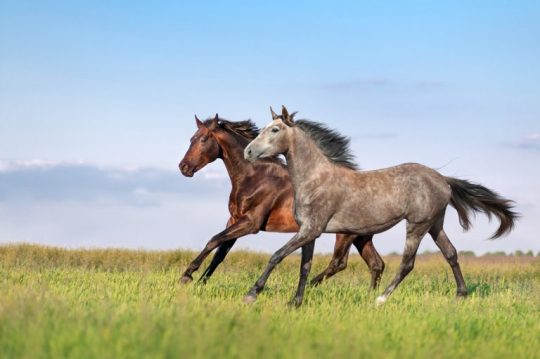
Horses
Horses display cognitive thinking and have great memory. Lipizzaner stallions, for example, can walk and “dance” in very intricate patterns. In one study, horses were shown to be able to identify different shapes and sizes by tapping a touch-screen monitor with their noses.
Be mindful about teasing a horse with a carrot: if he decides to retaliate, what’s a minor head bump to him could land you in the hospital with a concussion. Who’s the smarter one now?
0 notes
Text
10 Best Dog Breeds For Seniors
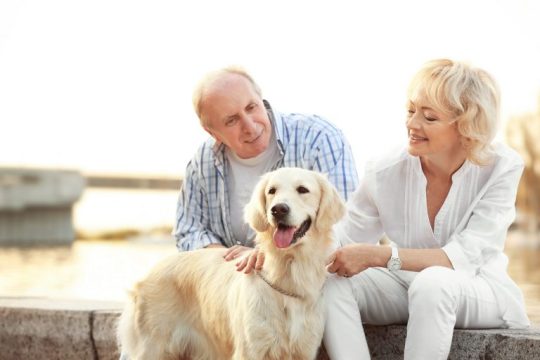
Dogs are called man’s best friend for a reason. Few things are more comforting than the soft wriggle of a dog or their eager scamper when you open the door. A pet can be the perfect companion as you settle down into your golden years. While every dog is different no matter what its breed, dog breeds are a great place to start when looking for the perfect pet.
Take a look at this list of best dog breeds for seniors. The pooches that made the list are easy to care for, even-tempered and usually permitted in an assisted living community.
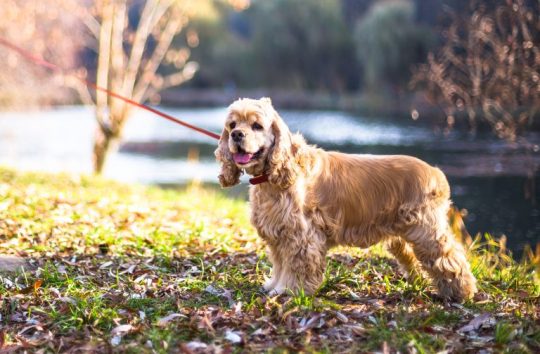
1. Cocker Spaniel
While not small enough for every assisted living community, cocker spaniels are still medium-small, averaging around 20 pounds. Though not necessarily lap dogs, they still make great pets as they are loyal, cheerful and enthusiastic. They have an even temperament, but they’re also high energy, so they’re not right for every senior.
A cocker spaniel needs attention, exercise and a regular brushing. Although they’re more high-maintenance than others on the list, their love of life makes the perfect match for many active seniors.

2. Schnauzer
Schnauzers are lovable, frisky and can easily become friendly yet fiercely loyal companions. Any dog that’s good with kids gets an A+ rating for those seniors who regularly have grandkids visiting, though their energy levels can be a negative for those seniors with health issues.
Schnauzers range in size, but even those communities with stringent pet size requirements will likely let in the miniature variety.

3. Pug
While not everyone likes the smashed-in face of a pug, those who do find it impossible to go back to any other breed. Pugs are small, so they easily fit community living requirements. They’re also adorable, eager, and know how to pour on the charm.
Despite having short hair they do tend to shed, but they require less exercise than most breeds. Pugs are a great companion for any senior with health issues that may prevent them from taking their pooch on a daily stroll.
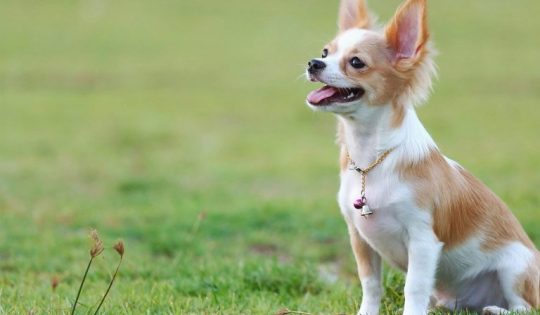
4. Chihuahua
If you’re in need of a small dog, then a chihuahua might be perfect for you. While many people think of chihuahuas as skinny and brown with a whip tail, chihuahuas come in many colors and two fur lengths. They’re affectionate, full of personality, and protective.
Chihuahuas tend to be barkers, however, so yours might need training to stay quiet. Since they’re so small, a few games of indoor fetch can supply their daily exercise.

5. Beagle
One of the classic dog breeds, beagles are funny, easy-going and playful. You could go for a good old-fashioned cliché and name your beagle Snoopy, since the popular Peanuts character is, in fact, a beagle. Beagles easily make friends with everyone, including other dogs.
They can be strong-minded, however, so don’t expect their training days to be easy! They shed, but don’t require very much brushing. Beagles need lots of exercise, so they’re not the right fit for an inactive senior.

6. Shih Tzu
A perfect size, shih tzus are bred to be companion dogs. They live a long time, enjoy curling up in their owner’s lap, and have a frisky, charming personality. They’re alert, high-energy dogs, and they do tend to bark. If you need a quiet, mild mannered dog, shih tzus may not be the best choice for you.
If you’re looking for a friendly and affectionate dog, however, they’re well worth the consideration. They require both a daily walk and indoor playtime and make excellent companions for the senior living an active retirement.

7. Pomeranian
While Pomeranians can be noisy, they’re also small, cute and intelligent. They love to please their owners and they love getting attention. As long as they get their daily dose of playtime and affection, they don’t require as much exercise as other dog breeds.
They also don’t need much grooming except for a regular brushing of their tail. If barking isn’t a concern, or you can find a pom with a mild personality, they could be the perfect breed for you.

8. Poodle
One of the most intelligent breeds, poodles come in many sizes. From the size of a golden retriever to the size of a Chihuahua, poodles are prized for the fact that they don’t shed and are hypoallergenic.
Poodles are proud, easy to train and adaptable. They do require a good amount of exercise, though, so make sure you have a playtime plan before you adopt one.

9. Yorkshire Terrier
Yorkshire Terriers have beautiful long hair that requires regular grooming, but it’s worth it for those who love these silky pooches. Yorkshire terriers need a daily walk, but don’t require excessive exercise.
They’re small, intelligent, and eager and their love of attention and human interaction makes them a perfect companion animal – especially for seniors living alone.
Yorkies can get bossy and protective, but some good training at the beginning usually paves the way for a drama-free relationship.

10. Boston Terrier
Boston Terriers are another breed of dog specially bred to be a companion. They’re a manageable size, friendly, and easy to groom. They love to bond with their owners and cuddle up in the evening. Boston terriers are attentive to their owner’s needs, and besides being playful and easily-pleased, have a friendly nature that makes them a hit with many seniors.
The right dog can make a happy retirement even more fulfilling. Make sure you do your research and choose a breed that fits your lifestyle to ensure a perfect match.
0 notes
Text
8 Signs Your Pet Is Spoiled

We love our pets. For just a little time, attention, and perhaps a few walks around the neighborhood, we get unconditional love and devotion. However, some pet owners go a little overboard for their pets. To show their love and affection, they indulge their pets to the point where they’re completely spoiled and ruling the roost. Do you think you have a spoiled canine on your hands? Here are eight signs to look for.

He Goes to the Salon More Than You Do
Being a responsible pet owner means keeping your dog clipped, groomed, and looking and feeling his best. However, if your dog is getting more attention at the groomer than you get at your own salon or barber, you may have an issue. Your pet probably doesn’t care if he’s got the latest en vogue cut or his nails painted, but pet owners who tend to spoil their companions feel they’re not doing right by their pooch if they don’t pamper them.

He Doesn’t Listen
Those who want to have a harmonious relationship with their pooches know that training is key. When your pet is trained well when he’s a puppy, he recognizes his name and responds to simple commands like “sit,” “stay,” and “fetch.” He’ll also obey when you train him not to get on the furniture or give visitors a good sniff when they walk in the door. If your dog doesn’t obey commands (or even look up when you call his name), it’s likely he’s ignoring you because he knows he can. A spoiled dog is often one that knows that bad behavior never results in negative consequences.

A Good Portion of Your Paycheck Is Spent on Him
Your dog needs good food, adequate shelter, and plenty of love and attention from you. However, he probably doesn’t need doggie ice cream, weekly trips to the groomer, beds in every room of the house, and every dog toy ever made. If find yourself working overtime just to pay for all the “extras” you think your pooch must have, you’ve probably got a spoiled mutt on your hands.

He’s Obese
We know, it’s tough to ignore those sad eyes on a pup who wants to convince you he’s always starving. However, if you indulge him in too much food, too many treats, or too much of your own meal slipped under the table, you’re likely to have an overweight canine.
Though it’s a sign of being spoiled, it’s also a sign of being unhealthy. Obese dogs are more likely to have high blood pressure, diabetes, liver disease and arthritis, so you’re not doing your best friend any favors by over-feeding him. If you want your companion to have a long and healthy life, you need to limit his food and help him maintain a healthy weight.

He’s Got His Spot — And He’s Not Moving
It’s one thing to let your pooch settle on the couch with you for a good long Netflix-binge, but it’s quite another if your dog has taken over your furniture and you find yourself sitting on the floor. If your pet has staked his claim in any of the spots that previously used to be yours — and if you indulge him enough not to make him move — you’ve definitely got a spoiled mutt in the house.

He Sets the Schedule
Nap time, feeding time, walk time… all of this should fall into a schedule that works well with your busy lifestyle. However, if your pet sets the schedule for you by waking you early in the morning for walks, howling and throwing a fit whenever he wants to eat and continually scratching at the door until you take him for a walk, you’ve got a furry dictator on your hands.

He’s Got Clothing—Lots of It
Okay, so it might be cute to put your Chihuahua in a tiny Christmas sweater at the holidays to impress the in-laws. But if you’ve got a whole dresser full of clothes for your pooch — including a selection of Halloween costumes, dress-up clothes, and a variety of vests and sweaters to dress him in when you go for walks — you may have a problem.

He Always Gets Your Attention First
If it’s just you and your dog living together, it may not be an issue that you instantly lavish attention on him as soon as you walk in the door. However, if you’ve got a significant other or kids in the house and you’re constantly putting their needs second after your needy hound, you’ve probably got a spoiled pet. People come first and if you constantly show your pooch that he can get your attention whenever he wants it, he’ll just keep demanding more and more.
It’s wonderful to have a close relationship with the canine you share your life with. But if you’re going broke, ignoring those close to you, and always bending to the schedule HE thinks is appropriate, you may need to re-evaluate and make some changes.
0 notes
Text
8 Dogs Who Were Famous Before The Internet Was Invented

It seems like everyone’s dog has a dog Instagram account today, but dogs have been going viral for hundreds of years. Here are eight great canines known and loved the world over before the Internet was a thing.
Rin Tin Tin
This German Shepherd (and there are several on this list) was discovered on a battlefield in France during the first World War by an American soldier who took the dog home with him and trained him to act in silent movies. He ended up making almost 30 films over his lifetime and, according to Hollywood legend, saved Warner Brothers studio from bankruptcy before talking movies were even invented. He even has his own star on the Hollywood Walk of Fame.
Hachiko
In the 1920s, a Japanese akita named Hachiko was so faithful that he would meet his master, Professor Ueno, at the Shibuya train station every evening and walk him to the train the morning. The professor had a sudden attack at work and died. Hachiko waited for him to get off the train, and when he didn’t, Hachiko came back to meet the next day’s train. He continued to do this every day for almost ten years. This dog didn’t get a star, but he did get a statue at the train station and the love of the whole nation.
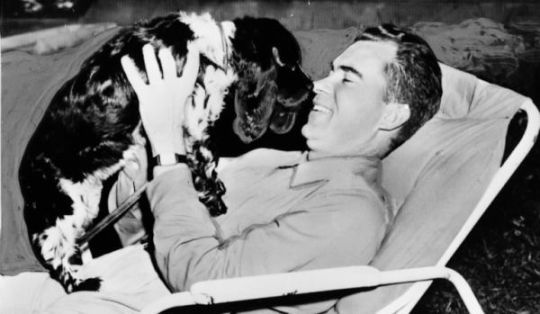
Checkers
Famous as part of one of the biggest political speeches of all time, Checkers was a cocker spaniel belonging to then-Senator Richard Nixon. During his campaign as Eisenhower’s presidential running mate in 1952, Nixon was accused of accepting private donations, which was a big no-no back then. As it happens, one of those donations was this dog to Nixon’s daughter Julie. Nixon went on national television and delivered what’s referred to as “The Checkers Speech,” in which a candidate averted disaster by deflecting the mistake, saying in essence, “But the kids love this dog, do you really want me to take it away from them?” — and he won the vice presidency. Although Checkers is well-remembered as Nixon’s dog, he passed away in 1964, four years before Nixon himself was elected president.
Old Drum
This hound dog became famous only after his death, but he became a symbol for dogs everywhere. In 1869, An attorney named George Graham Vest took the case of a dog who was shot by a neighbor. The owner sued for damages and Vest’s closing arguments, known as “Eulogy to a Dog” and including the phrase “Man’s Best Friend,” managed to create a legal precedent regarding how dogs are viewed in court matters. Vest won the case, and later became a U.S. senator; a bust of the dog is in the Missouri Supreme Court building in Jefferson City.

Balto
The world’s most famous sled dog, Balto was part of a life-saving team in 1925 that made a 650-mile trek in a blizzard to deliver diptheria serum from Nome to Anchorage, Alaska in just 5 days. The same route is the Iditarod trail — and the famous dog sled race was created in honor of this historic run. There’s a statue of Balto in New York’s Central Park and his taxidermied remains are displayed in the Cleveland Museum of Natural History.
Buddy
You may not know this German Shepherd but you know what she inspired. In 1928, a 20-year-old named Morris Frank, blind for four years, acquired a dog in Switzerland that had been specially trained to lead the blind. In front of incredulous reporters, he crossed a dangerously busy street known as Death Avenue with the dog leading him safely to the other side. Buddy was the first guide dog in the U.S. Six months later, Frank founded the Seeing Eye organization to train dogs to assist humans.
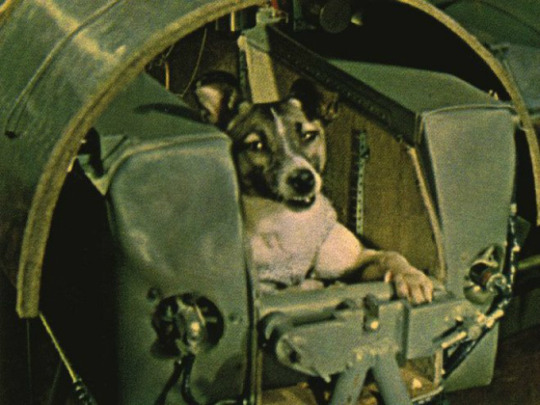
Laika
Back in 1957 the space race was underway; after successfully launching Sputnik 1, the Soviets chose a former stray mutt named Laika to be the first live being launched into orbit. Unfortunately, the launch was a one-way trip. The official story was that she was euthanized by remote after six days in orbit but the truth was she died just a few hours after launch due to high temperatures. But her short flight did pave the way for future crewed missions.
Pompey
The oldest entry in this list is a pug dog belonging to William, Prince of Orange, in the 16th century. “William The Silent” was nearly assassinated while in France; Spanish insurgents tried to enter his tent at night during a military campaign, but his dog woke him up by jumping on his face. The dog was honored by being immortalized next to the prince on his tomb at the church of St. Ursula in Delft, Netherlands.
0 notes
Text
8 Cats Who Were Famous Before The Internet Was Invented

Just like dogs, it doesn’t take much for a cat to become famous nowadays, if you have access to a camera and a good understanding of how social media works. But in the past, cats didn’t need to play the piano on YouTube to go viral. Here are some of the best known cats in history, before history went digital:
Catterina, the cat who owned Edgar Allan Poe
Writers and cats go together like pints of ice cream and spoons, so it’s no surprise that Edgar Allan Poe’s cat makes the list. While Poe wrote a terrifying (of course) tale called “The Black Cat,” his actual cat was a tortoiseshell, named Catterina. She reportedly perched on his shoulder as he sat down to write, probably to give him storytelling pointers. Catterina also tended to Mrs. Poe, who was losing a battle with tuberculosis, by lying next to her to keep her company until the end. Catterina reportedly died shortly after Poe himself died. Perhaps she was a figment of Poe’s imagination, or, more likely, he was a figment of hers

Snowball, the cat who owned Ernest Hemingway
Renowned writer Ernest Hemingway kept many cats throughout his life, but his first was an all-white kitten named Snowball gifted to him by a ship captain named Stanley Dexter. What made Snowball unusual is he was polydactyl, having six toes on his front paws instead of the usual five — cats with extra toes are considered lucky at sea. Snowball lived a nice happy life in sunny Key West, Florida.
Why he is so famous is that his many descendants still live at the Ernest Hemingway Home and Museum, and many of them also have extra toes. And in 2017, all 54 of the current generation of Hemingway cats survived the wrath of Hurricane Irma, so I guess they’re lucky on land, too.
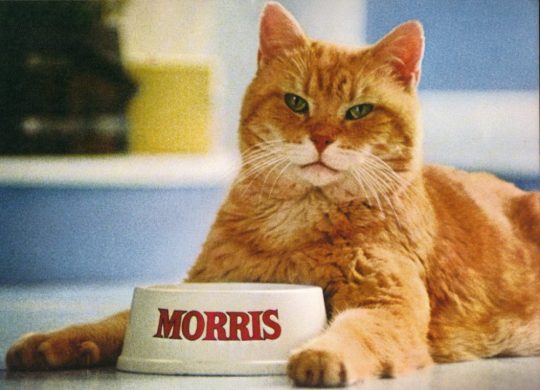
Morris, the cat who owned 9Lives Cat Food
Probably the most famous advertising cat in the world, Morris started out as the spokes-purrson for Purina’s iconic pet food in typical Hollywood fashion — he was discovered by talent scouts. Adopted from a shelter, the “finicky” orange tiger-striped cat first appeared in print in 1968, and until 1978 was the most popular cat in the world.
When the original Morris died, a new Morris — also a rescue cat — took up the mantle as pitch-cat. There have been other Morrises to follow since, as a beacon not only for pet food, but also pet adoption and rescue. The current Morris is living it up in Los Angeles, California.

All Ball, the cat who researched Koko the Gorilla
Koko the gorilla, the first non-human to be able to communicate in sign language, had a simple request for Christmas in 1983: she wanted a kitten. Her research team tried giving her a stuffed toy but she wanted a real one. After much deliberation they decided to let her adopt a kitten for her birthday in 1984. Koko chose one out of a litter, a male Manx kitten with no tail, and signed the cat’s name as All Ball.
Koko and All Ball made headlines all over the world as she took gentle care of him as if he were her baby. But it was not to last; after just a year together, All Ball got out of the research building and was struck by a car. Koko was inconsolable, signing “bad sad” over and over again. While she eventually got more kittens, she never forgot All Ball.

Room 8, the cat who went to school
Room 8 was a huge gray tabby that wandered into Elysian Heights Elementary School in Southern California one day in 1952. Named for his “homeroom,” he patrolled the grounds fastidiously; he came to school every day during the year and during summer recess we assume he took a sabbatical to a bird sanctuary.
He became the school’s mascot and was beloved, subject of books and movies and even a fashion spread in Look magazine. He finally retired over the Rainbow Bridge at 22 years old, and was buried with honors at the famous Los Angeles Pet Memorial Park.
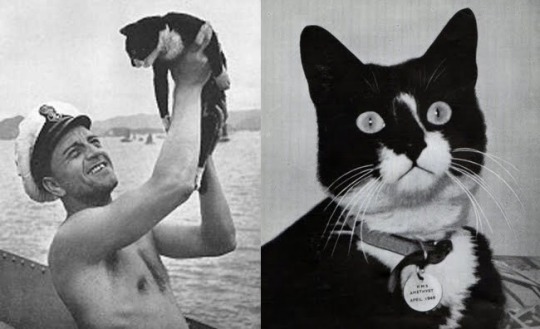
Sam, the cat who sank the Bismarck
This cat may not have polydactyl toes but he sure was lucky, though the same can’t be said of his ships. His first assignment was on a very famous vessel; unfortunately it was the Bismarck, a German battleship famous for A) being supposedly unsinkable and B) being sunk on its maiden voyage.
The cat was found floating on bits of shipwreck by the British Royal Navy and brought aboard, and given the name Oscar (what his name was aboard the German ship is unknown). He then went on to sink two more ships in the same way, and was renamed Unsinkable Sam. The Navy finally got wise and gave Sam to a sailor who had gone ashore, and as far as we know, caused no more maritime disasters.
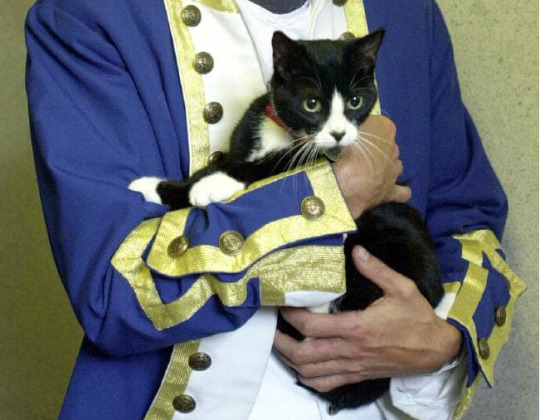
Trim, the cat who discovered Australia
Way back in the late 18th century, when sailing around “discovering” things was a career, Captain Matthew Flinders took his cat with him. Trim, a tuxedo, served on Flinders’ ship HMS Reliance and then on HMS Investigator, which mapped the entire circumference of Australia between 1801 and 1803.
However, on his return to England, Captain Flinders was captured by the French, because of a little war with Napoleon, and he and Trim were imprisoned on the island of Mauritius for a time. Flinders survived and was released; Trim however went missing and Flinders assumed he was eaten by another prisoner. There are statues of Flinders and his faithful companion Trim in both his English hometown and in several Australian cities.

Tabby and Dixie, the cats who ruled the White House
Tabby and Dixie were two kittens gifted to President Abraham Lincoln by his secretary of state William Seward in 1861, and they became the first official White House pets. Although technically Tabby belonged to Lincoln’s son Tad, Tabby and Abe were fast friends.
Lincoln reportedly even fed the cats at the table during formal dinners, claiming Dixie was smarter than his entire cabinet. When a reporter asked Mary Todd Lincoln if the president had any hobbies, she replied: “Cats.”
0 notes
Text
8 Tips To Help Your New Puppy Adjust
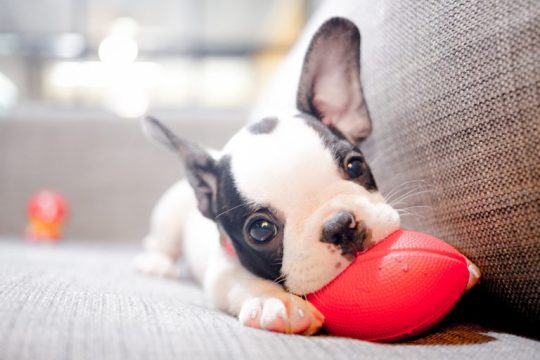
If you’re the proud owner of a newly adopted puppy, then you want to do everything in your power to help your pet transition well.
It can be hard for a puppy, however, to adjust to a new home and a new family.
For help with that new sense of belonging, check out the following list of to-dos.

1. Watch What They Eat
Your puppy has just moved into a new home, and he might be stressed. He’s in unfamiliar surroundings, being cared for by strangers, and he’s been separated from his mom for the first time.
While he’s so stressed out, your puppy might lose his appetite. Watch what he’s eating, and make sure he gets enough food. Talk to your vet about coaxing his appetite if you need to.

2. Keep Your Schedule The Same
You probably just want to spend all day with your puppy. After all, she’s too cute for words! It’s best for your puppy, however, if you stick to your regular routine. Set a specific time for feeding, walking, and playing with your new puppy.
Once she knows there’s a routine in her new home, she’ll feel much more relaxed. A routine will help her adjust more quickly and will help you with training down the road.

3. Give Them A Special Spot
When a new puppy arrives, everyone wants to pet him. Everyone! Even your neighbors want to come over and say hello to the new addition. While some puppies thrive on attention, your dog should know he has his own space.
Set aside a dog bed or kennel, and when your puppy goes to this spot, let him be. He’ll feel much safer knowing he has boundaries and a space where he can be by himself.
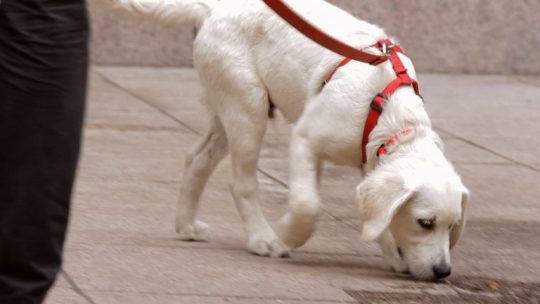
4. Keep Them on a Leash
A new puppy might seem safe in the backyard, but make sure your puppy is on a leash at all times. When she first arrives at your home, she might be tempted to run away, or go exploring. Remember she isn’t trained and she won’t come when you call.
An open gate could mean an escape attempt, and you never know who might open your gate, or come walking past to attract her curiosity. Keep her on a leash whenever she’s outside, even if she seems docile.
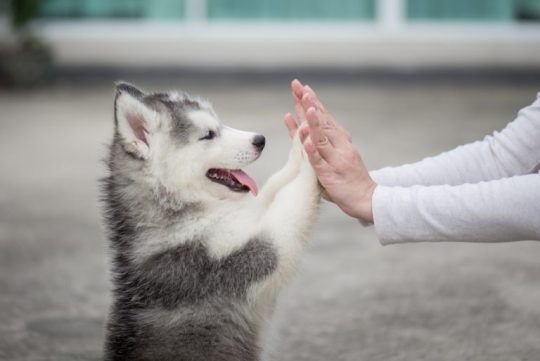
5. Don’t Make Too Many Changes
Your puppy has already gone through a lot. He’s living in a new home. He’s eating new food. He’s being fed and held by new people. With all these new changes, it’s hard for him to experience any more.
As much as you can, avoid new changes. Don’t pressure him to like you right away, and try to let him learn at his own pace. When it comes to exploring his new life, let your puppy lead.

6. Practice Alone Time
Most dogs need to be left alone in a crate sometimes, whether their owner is at work or out running errands. You might want to get your puppy used to a crate right away.
If you train her right, her crate can become a place of relaxation, and she won’t feel stressed being tucked inside for a few hours. Get her used to her crate, and try to make it a positive experience. She might choose to hang out there all on her own!
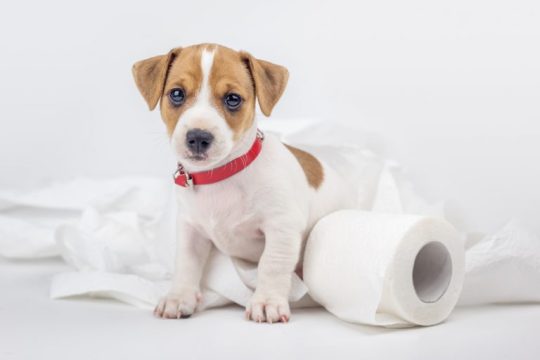
7. Start House Training
Every puppy needs to be house trained. He doesn’t want to keep using newspapers as a toilet, and you don’t want him to, either! Right away, start house training your puppy.
You might start out by filling his home base with newspaper, then limit it to a few squares. If you reprimand him when he goes off the paper, but praise him when he goes on the paper, he’ll soon learn to use the newspaper only. Then, you can transition the newspaper outside.

8. Stay Patient
New puppies aren’t perfect. In fact, your puppy can get into all kinds of trouble. It might take her weeks to finish her house training, and when you’re not looking, she might destroy an entire pile of magazines. Some dogs only chew chew-toys while others chew on furniture!
Your puppy might cause you all kinds of unforeseen problems, and it’s important to be patient. Eventually, she’ll learn what she can and can’t do. Until then, keep your valuables up high and practice patience.

A new puppy is a wonderful gift. He or she can be a lot of trouble, but will always be worth it in the end.
With a new puppy, you’re getting to know a new best friend, and the experience can be amazing.
Rely on some of these tips to help your new puppy adjust and you will soon be enjoying a new life together.
0 notes
Text
10 Foods You Should Never Feed Your Dog Or Cat

When you bring a dog or cat into your home, you want to treat them like a valued member of the family. It can be tempting to give them extra treats or share your food with them. That idea is perpetuated by taking home a “doggy bag” from a restaurant as well as how we see pets portrayed in movies and television shows.
While with some foods it is perfectly fine to share, there are foods that can lead to serious health problems or even death in your pet. Many commonly thought of “treats” are instead foods that are dangerous for your dog or cat. These two lists include foods to avoid for both dog and cat owners.
Five Foods to Avoid for Dogs:
Zylitol
Zylitol is a sweetener that can be found in baked goods, gum, and some diet foods. If your dog eats something containing Zylitol, it can cause a drop in blood sugar. If you think your dog has gotten into something with Zylitol, here are some early symptoms to look out for: vomiting, coordination problems, and lethargy. If not treated, this can lead to seizures and liver failure within a matter of days.

Onions and Garlic
Onions and Garlic, in any form, are harmful for your dog. If ingested at all, they can kill your dog’s red blood cells, which eventually leads to anemia (a condition marked by a deficiency of red blood cells or of hemoglobin in the blood). If your dog eats a large quantity, even just once, it can lead to poisoning. Things to watch out for if you think your dog has ingested onions or garlic including breathing problems, weakness, and vomiting.
Caffeine
Caffeine is in so many things in your house, including: coffee, tea, chocolate, caffeinated soda, medication, and energy drinks. Ingesting any of these things containing caffeine can be fatal to your dog. If you suspect your dog has gotten into something with caffeine, take them to the vet immediately.

Macadamia Nuts
It only takes six macadamia nuts to make your dog sick. The symptoms to look for if your dog has eaten macadamia nuts include: high temperature, vomiting, weakness in back legs, and muscle shakes. Macadamia nuts are dangerous on their own, but mixing chocolate with macadamia nuts can lead to death in your dog.
Pitted Fruits
Persimmons, peaches, and plums should be kept out of reach of your dog. While the fruit is okay (although not ideal) for your dog, the pit is dangerous. There are two issues with these fruits, both are found in the pits. The pits from these fruits can cause an obstruction in the small intestine, if swallowed. Secondly, cyanide is present in peach and plum pits, which will poison your dog if ingested.

Five Foods to Avoid for Cats:
Alcohol
Alcohol can become a serious issue for your cat. Not only can cats get drunk, which is not healthy for them, it also takes a very small amount of alcohol to cause brain and liver damage. If your cat ingests as little as a tablespoon of alcohol, they could lapse into a coma. More than a tablespoon can lead to death.
Dairy
Milk and dairy products, while commonly associated with cats, can cause digestive problems. Cats are generally lactose-intolerant, so it is safer for your pet to not place down that saucer of milk.

Grapes
Grapes and raisins have been known as treats for cats, but they should not be. A small amount of grapes or raisins can make your cat hyperactive and vomit repeatedly. While some cats tolerate grapes and raisins well, others react so poorly it is best to keep them out of reach of all of your cats.
Raw Eggs
Raw eggs can cause the same issue for cats that they do for humans. If there is any bacteria in the raw egg, it could lead to food poisoning. Raw eggs can also create an issue with your cat’s absorption of biotin, which can cause skin and coat issues.

Tuna
Tuna is another thing that the people think is good to give to your cats, when in fact it can lead to health issues. There are two types of tuna, one for humans and the other for cats. Feeding a cat a tuna-based cat food is just fine, the trouble comes in when you feed tuna for human consumption to your cat. Tuna that is made for humans does not have the nutrients needed to support your cat’s nutritional needs and can also cause inflammation of the fat cells in your cat’s body when fed on a regular basis.
Having pets is a joy as well as a responsibility. Hopefully these lists of dangerous foods, while not exhaustive, are a good place to start in keeping a happy and healthy pet in your home. If you think that your pet has gotten into anything on these lists, or any other food that is potentially dangerous, please contact your veterinarian immediately for further advice.
1 note
·
View note